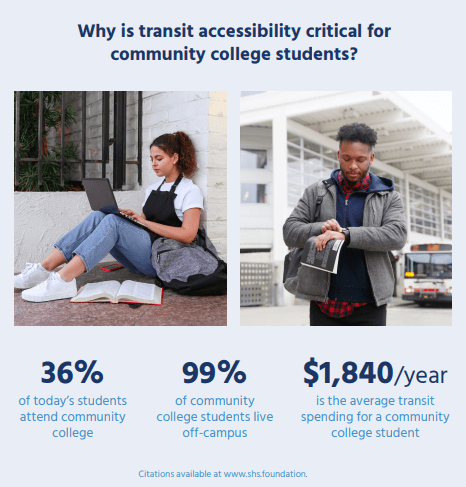 Are community colleges accessible by public transit? Does a student need to own a car to attend community college? Transit infrastructure is a critical component of community college access and affordability, but the absence of national survey data and analysis has hampered coordinated support for students. The Seldin/Haring-Smith Foundation (SHSF) Public Transit Map offers a first look at transportation accessibility at America’s community and technical colleges. Our team has produced a national analysis of transit accessibility at community and technical colleges. The (in)accessibility of community colleges via public transportation is a key equity issue that cuts across transit, workforce development, and higher education.
Are community colleges accessible by public transit? Does a student need to own a car to attend community college? Transit infrastructure is a critical component of community college access and affordability, but the absence of national survey data and analysis has hampered coordinated support for students. The Seldin/Haring-Smith Foundation (SHSF) Public Transit Map offers a first look at transportation accessibility at America’s community and technical colleges. Our team has produced a national analysis of transit accessibility at community and technical colleges. The (in)accessibility of community colleges via public transportation is a key equity issue that cuts across transit, workforce development, and higher education.
Are community colleges transit accessible?
Our analysis found that 57 percent of community and technical college main campuses have a transit stop within walking distance. Nearly half of these colleges have transit stops within 0.2 miles, often transit that stops right on campus. But for 37 percent of community colleges, the nearest transit stop is more than one mile away, including approximately 250 institutions located in areas with no existing public transit infrastructure.
Our team identified 345 institutions with a transit stop between 0.5 mile and 4.5 miles away from campus. In some cases, improvements would require extending an existing bus line; other schools would only require a slight route adjustment of a bus line to provide close access. In some situations, where the only nearby transportation is a rail station, a shuttle service could close the gap. The opportunity to expand transit accessibility at these 345 colleges is distributed throughout most of the country, and across all types of American communities. There are more target institutions in sparsely populated areas, but schools in denser areas tend to accommodate more students.
Why is transit accessibility critical for community college students?
Community college faculty often note that their students are “one flat tire away from dropping out.” Strong and multi-faceted transit solutions can keep students on the path to graduation. Instead of being “one flat tire away from dropping out,” students should be “one transit stop away from enrolling and graduating.”
Why is public transportation accessibility to community colleges an equity issue?
Working students, parenting students, students from low-income backgrounds, and students of color are overrepresented at community colleges. For students juggling family, work, and school commitments, transportation is a critical component of community college access and affordability.
Currently, one in four community and technical colleges have public transit nearby, but not close enough to be practical for students. For students with disabilities, parents with strollers, students rushing to class before or after work, the distance between a stop and school is more than a matter of convenience. It may be the deciding variable between making it to school or not.
 What can leaders in higher education, workforce and public infrastructure do about this issue? How can this map be used to make their case?
What can leaders in higher education, workforce and public infrastructure do about this issue? How can this map be used to make their case?
For the one in four colleges with transit nearby, but no stop within walking distance, solutions are possible. By extending existing public transit infrastructure, we can ensure that more than 80 percent of community and technical colleges in the U.S. are accessible. Providing resources for communities to extend or reroute lines, create shuttle services, or add stops can create opportunities for prospective students who are transit dependent. In addition to serving current college students, transit access could help make college a reality for individuals who are considering college and have the peace of mind knowing transportation will not be a barrier.
As governments work to improve transit accessibility at community and technical colleges, they must understand the real-life needs of their students to ensure that solutions serve them effectively. Even at institutions with convenient stops, the cost of transit passes is a barrier for many students. Some colleges provide subsidized transit passes for their students, but this approach is not universal and discounts vary across colleges. Just like nearby transit stops, affordable transit passes can make enrollment possible for prospective students from low-income backgrounds who would otherwise struggle to pay. Low-cost steps like synchronizing class schedules and transit schedules can meaningfully impact students. Hourly transit service that gives students the choice of arriving 45 minutes early or 15 minutes late to class each day won’t work for students already battling “time poverty” as they balance school, work, and family. Equitable policy approaches to transit accessibility for community college students must address all of this: stops and routes, schedules, and cost solutions like subsidies.
To learn more about this critical issue, read the full brief, “Waiting for the Bus: Transit Infrastructure at America’s Community & Technical Colleges,” by Matthew Crespi, Ellie Bruecker, and Abigail Seldin.
To see how schools in your geography match up, visit the SHSF Public Transit Map.
Ellie Bruecker is a senior research associate at SHSF. Committed to bridging the gap between research and policy change, Ellie brings expertise in quantitative analysis, financial aid policy, and higher education data sources. She is the lead author of SHSF’s July report “Sex Trafficking in State-Authorized Massage Schools: A Case Study,” which was featured on the front page of USA Today and prompted an investigation by the House Oversight Committee.
Ellie has co-authored work with The Institute for College Access & Success and the State Higher Education Executive Officers Association, and previously worked at the University of Wisconsin-Madison’s SSTAR Lab. Ellie has presented her research on FAFSA completion at national and state conferences. She holds a Bachelor’s degree in Political Science and Sociology, and is completing a Doctorate in Educational Leadership and Policy Analysis, both from the University of Wisconsin-Madison.
